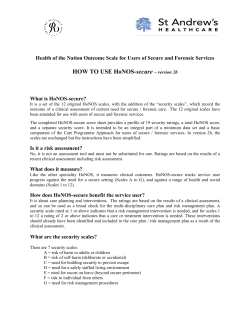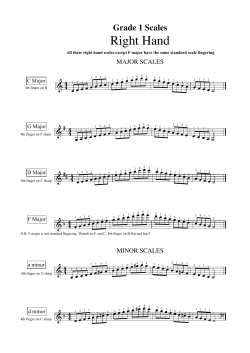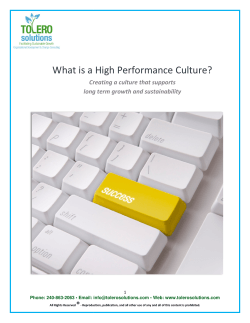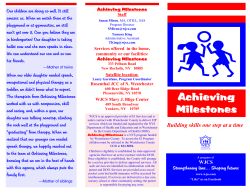
Creative Style questionnaire > Technical Manual
Creative Style questionnaire > Technical Manual Talent Development Copyright © 2014, MySkillsProfile.com Limited. www.myskillsprofile.com.com. CSQ is a trademark of MySkillsProfile.com Limited. All rights reserved. No part of this publication may be reproduced or distributed in any form or by any means or stored in a database or retrieval system without the prior written permission of MySkillsProfile.com Limited. 2 Contents INTRODUCTION ............................................................................................... 4 RELIABILITY .................................................................................................... 4 Internal consistency reliabilities ...................................................................... 4 VALIDITY .......................................................................................................... 4 Scale intercorrelations .................................................................................... 4 Standard error of difference ............................................................................ 5 Factor analysis ................................................................................................ 6 Relationship to other measures ...................................................................... 6 Criterion-related validity .................................................................................. 7 DEMOGRAPHICS ............................................................................................. 9 NORMS ............................................................................................................. 9 REFERENCES ................................................................................................ 12 3 Introduction This short technical manual describes key psychometric properties of the CSQ. Evidence for the reliability and validity of is presented against some of the key the criteria in the EFPA Review Model for the Description and Evaluation of Psychological Tests (Bartram, 2002).The EFPA Review Model was produced to support and encourage the process of harmonizing the reviewing of tests. It provides a standard set of criteria to assess the quality of tests. These cover the common areas of test review such as norms, reliability and validity. Reliability Internal consistency reliabilities Table 1 shows the CSQ scale reliabilities. The internal consistency for the questionnaire as a whole is 0.92 and the median internal consistency for the CSQ scales is 0.78 which is which is defined as good by the EFPA review model (Bartram, 2002). The CSQ scale sten score SEms all in the range of 0.8-1.1. This means that there is a 68 percent likelihood that the person’s true score on the scales will be about 1 sten either side of the observed score. The sten score SEm band around the CSQ total score is smaller (about .5) because the reliability is higher. Table 1. Internal consistency reliabilities for CSQ (n = 4,162) Scale Alpha Mean SD Raw score SEm Sten score SEm Original 0.75 36.45 5.65 2.82 0.98 Risk-Taking 0.79 31.52 6.23 2.86 0.95 Adaptable 0.70 37.48 5.27 2.89 1.07 Assertive 0.78 35.41 5.98 2.81 0.84 Achieving 0.78 37.70 6.15 2.88 0.78 Total Score 0.92 178.56 22.98 6.50 0.54 Validity Scale intercorrelations Table 2 shows the intercorrelations of the CSQ scales. There are moderate to high correlations between the scales ranging from 0.26 to 0.70. 4 Table 2. Intercorrelations of CSQ scales (n=4,162) Scale Risk-Taking Adaptable Assertive Achieving Original 0.65 0.70 0.57 0.51 0.56 0.55 0.26 0.49 0.49 Risk-Taking Adaptable Assertive 0.47 All correlations are significant at 0.01 level (2-tailed). In order to determine how well a questionnaire differentiates between the different dimensions it is designed to measure, it is necessary to correct the correlations for unreliability. A correlation needs to be divided by the square root of the product of the two variables’ reliability to determine what the correlation between the two variables would be if the variables’ reliabilities were perfect. If two scales share less than 50% reliable variance, then we can be reasonably certain that they are independent. Using 50% as a benchmark, it is apparent that there is a high degree of overlap between the Original, Risk-Taking and Adaptable scale pairs. The remaining scale pairs show a reasonable degree of independence (Table 3). Table 3. Percentage of common reliable variance for CSQ scales (n=4,162) Scale Risk-Taking Adaptable Assertive Achieving Original 71.31 88.61 59.51 42.75 56.71 55.40 11.11 43.97 39.46 Risk-Taking Adaptable Assertive 36.31 Standard error of difference The Standard Error of Difference (SEd) helps us determine the size of the gap that you need to see between a person’s scores on any two scales before you can conclude that the difference is real. The SEd depends on the reliability of the scales – the higher the reliability the smaller the SEd is. If there are two full SEds between the scores on two scales, then there is a 95% likelihood that there is a real difference. All the SEds in Table 4 are around 4 so a difference of around 8 or more in CSQ raw scores constitutes a real difference. This is equivalent to a difference of 3 Stens. 5 Table 4. Standard error of difference of CSQ scales (n=4,162) Scale Risk-Taking Adaptable Assertive Achieving Original 4.02 4.04 3.98 4.03 4.07 4.01 4.06 4.03 4.08 Risk-Taking Adaptable Assertive 4.02 Factor analysis Principal factors extraction with varimax rotation was performed on the CSQ scales on a sample of 2,118 respondents (see Table 5). The Kaiser-MeyerOlkin measure of sampling adequacy was 0.82, well above 0.6 required for a good factor analysis. The variables were on the whole well-defined by the factor solution. Communality values were moderate to fairly high. One factor was extracted accounting for 67% of the variance indicating that creativity and problem solving style measured by the CSQ is a single construct. Relationship to other measures The Kirton Adaptation-Innovation Inventory (KAI) is a 32 item questionnaire which provides a measure of creative style (Kirton, 1994). The KAI places people on a single global dimension where one end of the dimension represents ‘innovators’ and the other end represents ‘adaptors’. The KAI has 3 subscales: Originality, Efficiency and Conformity. The CSQ and the KAI were administered to a sample of 126 managers and professionals studying for a MBA at Manchester Business School. The sample spanned 28 nationalities. Table 6 shows correlations between the KAI total score and subscales and the CSQ total score and subscales. Table 5. Factor loadings and communalities for principal components extraction on CSQ scales (n=2,118) Scale F1 Communality Original 0.88 0.78 Risk-Taking 0.80 0.63 Adaptable 0.84 0.70 Assertive 0.78 0.61 Achieving 0.67 0.45 The CSQ total score and the KAI total score correlate significantly at 0.69 which is defined as good by the EFPA review model. The CSQ Original scale correlates significantly with the KAI Originality scale (0.67) and the CSQ Risk- 6 Taking scale correlates significantly with the KAI Conformity Scale (0.58). The pattern of correlations confirms that CSQ measures important elements of creative style. Regression analysis indicated that the CSQ subscales account for about 65% of the variance in the KAI total score. Table 6. Correlations between CSQ and the KAI (n=126) Scale Originality Efficiency Conformity KAI Total Original 0.67* 0.11 0.35* 0.54* Risk-Taking 0.59* 0.2 0.58* 0.63* Adaptable 0.61* 0.02 0.37* 0.49* Assertive 0.48* 0.05 0.33* 0.41* Achieving 0.28* -0.2 -0.03 0.07 Total Score 0.75* 0.17 0.56* 0.69* * p <.01 Criterion-related validity Table 7 shows the correlations between CSQ scale scores and job appraisal ratings. This is based on a sample of 1,960 respondents who completed the CSQ on the internet. Respondents were asked to report how their manager assessed their performance at their last performance appraisal using a 4-point scale (excellent, good, satisfactory, poor) and to assess their own performance. Combined ratings shown in the table are the sum of the manager’s assessment and the test taker’s self-assessment. There are statistically significant correlations at 0.1-0.4 between job performance and all four factors. These correlations are consistent with those reported in the literature for personality assessment instruments. For example, Robertson (1997) notes that even with meta-analytic corrections, the upper limits for the validity of personality variables against overall work performance variables are in the range of 0.25 to 0.4. Regression analysis was used to help understand the contribution of the different areas of emotional intelligence to job appraisal ratings. A standard multiple regression was performed between managerially and self-assessed job performance combined as the dependent variable and the CSQ scales as the independent variables. Table 7 displays the correlations between the variables, the unstandardized regression coefficients (B), the semi-partial correlations (sr ) and R, R and adjusted R . For the combined ratings, R for regression was significantly different from zero, F(5, 1954) = 68.89, p < 0.001. Two CSQ scales (Original and Achieving) contributed significantly to the prediction of job performance ratings (sr2 = 0.07), and the five scales in combination contributed another 0.07 in shared variability. Altogether, 14% of the variability in job performance ratings was predicted by knowing scores on the five CSQ scores. 7 ** B Beta Unique Achieving Assertive Adaptable Risk-Taking Scale Original Combined Assessment (DV) Table 7. Regression of CSQ scale sten scores on job performance ratings (n=1,960) 0.11 0.16 0.01** -0.06 -0.09 0.00 0.02 0.04 0.00 -0.02 -0.02 0.00 0.24 0.30 0.06** Original 0.26 Risk-Taking 0.12 0.68 Adaptable 0.24 0.70 0.58 Assertive 0.18 0.58 0.57 0.51 Achieving 0.36 0.51 0.30 0.50 0.48 Mean 6.44 5.69 5.72 5.61 5.81 6.06 R Standard deviation 1.34 1.97 2.08 1.96 1.80 1.64 Adjusted R 2 0.14 a 2 0.14 R 0.38 a P<0.01. Unique variability = 0.07, shared variability = 0.07. 8 Demographics Table 8 shows the correlations between the CSQ scales and gender and age in the standardization sample. There were three statistically significant correlations related to gender where the observed differences were very small. Men described themselves as very slightly more willing to take risks, very slightly more adaptable, and very slightly more achieving than women. There was no significant difference related to gender on the CSQ total score. There were statistically significant differences on the CSQ total score and all the scales related to age. The creative style scale scores increased slightly with age which suggests that men and women become more creative as they mature. The low magnitude of differences related to gender and age indicates that there is no need for separate norms related to age or gender. Table 8. Correlation with age and gender (n=4,000) Scale Gender Age Original -.01 .12 Risk-Taking -.09 Adaptable ** ** .14 ** -.07 ** .17 Assertive -.02 .05 Achieving .06 ** .12 Total Score -.03 .15 ** ** ** ** Gender was coded 1 for male and 2 for female. **. Correlation is significant at the 0.01 level (2-tailed). Norms CSQ norms are based on a large international sample of 4,000 respondents who completed the questionnaire on the internet. A sample was created with equal numbers of men and women between the ages of 16 and 64. The mean age of the sample was 31.7 with a Standard Deviation of 10.8. The majority of respondents were from the USA, the UK, Canada, and Australia. The age distribution of the standardization group is shown in Table 9. Approximately 65 percent of the sample was aged 16-34 with roughly equal numbers in the 16-24 and 25-34 age bands. Twenty percent of the group was aged 35-44 and the remaining 15 percent was aged between 45 and 64. The age distribution of men and women was similar. 9 Table 9. Age distribution of CSQ international norms sample (n=4,000) Age Men Percent Women Percent Total Percent 16-24 615 30.8 649 32.5 1,264 31.6 25-34 732 36.6 577 28.9 1,309 32.7 35-44 377 18.9 433 21.7 810 20.3 45-54 206 10.3 285 14.3 491 12.3 55-64 70 3.5 56 2.8 126 3.2 Total 2,000 100.0 2,000 100.0 4,000 100.0 Over 70 industry sectors were represented in the sample. Table 10 shows the top ten sectors representing about half the comparison group. Education was the largest sector in the standardization group making up 14.3 percent of the sample. Table 10. Top ten industry sectors in standardization group (n=2,182) Sector Frequency Percent Education 573 14.3 Computers/Software 233 5.8 Other Services 217 5.4 Advertising/Marketing 200 5.0 Consulting 183 4.6 Health Services 174 4.4 Arts/Culture 164 4.1 Computer-related Services 159 4.0 Engineering 140 3.5 Government 139 3.5 Total 2,182 54.6 The norms are presented in Table 11. 10 Table 11. CSQ general population norms (N = 4,000) Stens Scale Scale Mean SD 47-50 Original 36.45 5.65 41-43 44-50 Risk-Taking 31.52 6.23 43-44 45-46 47-50 Adaptable 37.48 5.27 39-40 41-43 44-45 46-50 Assertive 35.41 5.98 38-40 41-43 44-45 46-47 48-50 Achieving 37.70 6.15 179-190 191-201 202-212 213-221 222-250 Total Score 178.56 22.98 1 2 3 4 5 6 7 8 9 10 Original 10-24 25-27 28-29 30-33 34-36 37-38 39-41 42-44 45-46 Risk-Taking 10-18 19-21 22-24 25-27 28-30 31-34 35-37 38-40 Adaptable 10-25 26-28 29-31 32-34 35-37 38-39 40-42 Assertive 10-21 22-25 26-29 30-32 33-35 36-38 Achieving 10-23 24-27 28-30 31-34 35-37 Total Score 50-131 132-143 144-153 154-166 167-178 11 References Bartram, D. (2002a). EFPA Review Model for the description and evaluation of psychological instruments: Version 3.2. Evaluation Form. Brussels: EFPA Standing Committee on Tests and Testing (September, 2002). Bartram, D. (2002b). EFPA Review Model for the description and evaluation of psychological instruments: Version 3.2. Notes for Reviewers. Brussels: EFPA Standing Committee on Tests and Testing (September, 2002). Kirton, M. J. (1994). Adaptors and Innovators: Styles of Creativity and Problem Solving. London, UK: Thomson Learning. Robertson, I. T., Personality and Work Behaviour (1997) Keynote Address to 2nd Australian Industrial and Organizational Psychology Conference. SPSS for Windows, Rel. 11.0.1. 2001. Chicago: SPSS Inc. Tabachnick, G.T. and Fidell, S. (1989). Using Multivariate Statistics. Harper Collins Publishers, Inc. 12 Copyright © 2014, MySkillsProfile.com Limited. www.myskillsprofile.com.com. CSQ is a trademark of MySkillsProfile.com Limited. All rights reserved. No part of this publication may be reproduced or distributed in any form or by any means or stored in a database or retrieval system without the prior written permission of MySkillsProfile.com Limited.
© Copyright 2025










